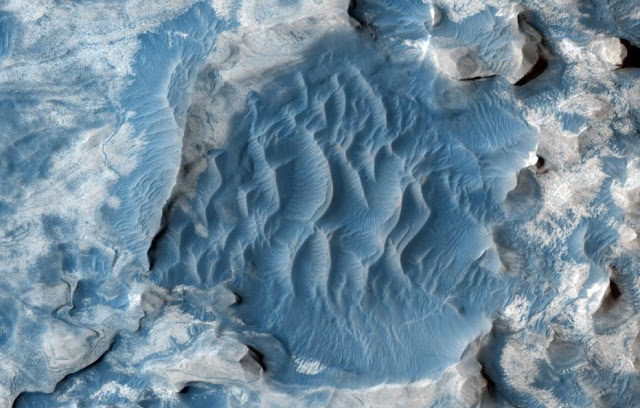which have been created
for a huge dimension of space & time.
how gorgeous and marvelous..
 This observation shows the contact between the hematite bearing plains and etched terrain in northern Meridiani Planum.
This observation shows the contact between the hematite bearing plains and etched terrain in northern Meridiani Planum.The hematite bearing plains (exposed at the bottom left of the full image) are dark, smooth and full of dune fields. This unit is laterally extensive and the same unit that the Mars Exploration Rover Opportunity was sitting on about 400 kilometers to the southwest (in 2007). Based on observations by Opportunity, this unit is interpreted to be a thin aeolian (wind-blown) mantle of basaltic sand and hematite concretions sitting on the etched terrain.
The etched terrain in this image is split into two units. The darker unit at the top of the image is filling in an approximately 120 kilometer NW-SE trending valley, while the brighter etched terrain in the middle of the image is stratigraphically and topographically higher than the lower etched terrain in the valley. This upper etched terrain is a plateau-forming unit with a geomorphic pattern that ranges from relatively flat plains to dissected plateaus and mesas. The lower etched terrain is flat with low albedo, and covered in dunes.
It is in these etched terrains that CRISM, and previously OMEGA, have detected hydrated sulfates, which makes a sedimentary origin seems most likely for these layered deposits of etched terrain found in Meridiani.
The University of Arizona, Tucson, operates the HiRISE camera, which was built by Ball Aerospace & Technologies Corp., Boulder, Colo. NASA's Jet Propulsion Laboratory, a division of the California Institute of Technology, Pasadena, manages the Mars Reconnaissance Orbiter for the NASA Science Mission Directorate, Washington. Lockheed Martin Space Systems, Denver, is the spacecraft development and integration contractor for the project and built the spacecraft.

Chopin.. Waltz
 This view of an inverted crater in the Arabia Terra region of Mars is among the images taken by NASA's Mars Reconnaissance Orbiter in early 2010 as the spacecraft approached the 100-terabit milestone in total data returned.
This view of an inverted crater in the Arabia Terra region of Mars is among the images taken by NASA's Mars Reconnaissance Orbiter in early 2010 as the spacecraft approached the 100-terabit milestone in total data returned.The orbiter's High Resolution Imaging Science Experiment (HiRISE) camera recorded this image on Jan. 29, 2010, and the spacecraft surpassed 100 terabits about three weeks later. That is more than three times as much data as the combined total from all other NASA missions that have flown farther from Earth than the orbit of Earth's moon. The Mars Reconnaissance Orbiter reached Mars in 2006 and completed its primary science phase in 2008.
The inverted crater seen here spans about 250 meters (about 800 feet) in diameter. Sand in the dark dunes around the crater was probably derived from basalt, a black volcanic rock that is common on Mars. Most craters are depressions, but this one sticks up above the surrounding plains. Such "inverted topography" is found on Mars and Earth where erosion has stripped away surrounding topography. In this case, the crater was filled with sediment, and then subsequent erosion stripped away the terrain around the filled crater.
This image covers a swath of ground about 600 meters (about 2,000 feet) wide at about 3 degrees north latitude, 5 degrees east longitude. It is one product from HiRISE observation ESP_016459_1830, which was taken during Mars' northern-hemisphere spring. Other image products from this observation are available at http://hirise.lpl.arizona.edu/ESP_016459_1830.
Image & description Credit : NASA/JPL-Caltech/University of Arizona
No comments:
Post a Comment